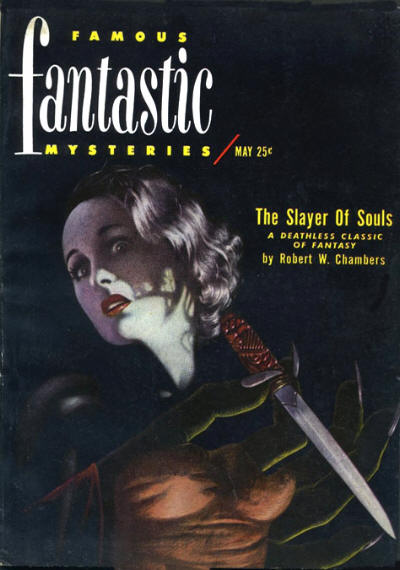Forefathers of Sword and Sorcery: Robert W. Chambers
"But my favorite writers, both of prose and verse, are British or Americans. They are (...) R.W. Chambers (...) and last, but no means least, yourself."
— Robert E. Howard to H. P. Lovecraft, December 1932
"Robert W. Chambers has probably been the most profound influence upon my work... Much of my work has resonances of Robert W. Chambers. While almost all of his books were hack-work romances, the best of his supernatural horror can stand with the very best. The primary lesson I’ve learned from reading Chambers was to create a deliberate barrier against final comprehension — thus creating the lost uncertainty of an extended nightmare."
— Karl Edward Wagner, Autumn 1994
Note: This is another post in an occasional series which looks at the literary figures who influenced the creators of sword and sorcery. The focus will be upon the writers who influenced the "first wave" of S&S authors (such as Robert E. Howard, Clark Ashton Smith and CL Moore).
Robert William Chambers died eighty-five years ago today. Once one of the most popular authors in America—albeit mostly for his "shop girl romances', literary precursors to modern rom-coms—Chambers' handful of weird tales are what keep him in the public eye a century later.
Chambers was born with a silver spoon in his mouth and a natural flair for poetic, flowing prose. He was also no mean painter and his parents paid for him to study art in Paris. This sojourn in France would lead to his greatest work, The King In Yellow, a collection of loosely-connected tales set in Paris and Brittany. This collection is the linchpin of RWC's present literary reputation.
Lovecraft was one of the first weird fiction critics to single out The King In Yellow for (qualified) praise in his treatise, "Supernatural Horror in Literature." Many other critics have since lauded its fever-dream atmosphere, filled with madness and nameless dread. We also know that A. Merritt was a fan of Chambers. Edgar Rice Burroughs held several RWC novels in his personal library.
In popular culture, The King In Yellow formed the foundation for the first season of True Detective, which sparked a sharp upsurge of interest regarding Chambers' book. Long before that, however, there had been various anthologies written by diverse hands devoted to exploring RWC's Carcosa and the King In Yellow. By my rough count, there have been nearly ten such in the last two decades or so, most in the last ten years. Obviously, there are those out there still intent upon finding the Yellow Sign.
So what has Chambers to do with sword and sorcery? The quotes above from Robert E. Howard and Karl Edward Wagner—read the full interview here—are evidence enough, in my opinion. In addition, Clark Ashton Smith ranked "The Yellow Sign" from The King In Yellow amongst his favorite weird tales of all time. Jack Vance grew up reading Chambers.
In the case of Robert E. Howard, the influence of Chambers runs deeper than just The King In Yellow. In fact, it's possible that particular volume was read much later by REH than several other tales from Chambers. A look at Howard's bookshelf shows he owned numerous novels written by RWC and none of them were The King In Yellow. No, all of the works owned by REH were from Chambers' later period, when he was one of the bestselling authors in the US.
The novels in Chambers' "Cardigan" series such as The Little Red Foot and America—books owned by Howard—are set during the American Revolution. Howard scholar, Rusty Burke, collated the texts of the three Cardigan novels owned by REH. He concluded that they were the source of nearly all the place-names found in Howard's Hyborian Age tale, "Wolves Beyond the Border." The political situation in the tale also echoes that found in the Cardigan novels. Some of the place-names used in WBtB were then carried over to the classic Conan yarn, "Beyond the Black River." Basically, Chambers provided inspiration and a partial template for Howard's "Pictish frontier" tales. Personally, I think that Howard also might have read RWC's The Hidden Children, which is part of the Cardigan series and shares a northern New York setting with the other novels. The Seneca shaman, Amochol, bears some resemblance to REH's Zogar Sag, in my opinion. The Hidden Children was published earlier than the three Cardigan novels we know Howard read. It was also made into a silent movie in 1917. I don't think it unlikely that Howard read the book.
The other big RWC influence we see when it comes to Howard is Erlik, the primal god of the Hyrkanians and later Turco-Mongols in REH's tales. While Harold Lamb mentioned Erlik a few times in various tales, the overwhelming evidence points to Chambers being the primary influence in this case. We know that Howard owned The Slayer of Souls, which is all about an Asian Erlik cult seeking to dominate the world. In addition, pulp scholar, Rick Lai, has pretty definitively established that REH read The Dark Star, which is also concerned with Erlik.
So, raise a glass to the shade of Robert W. Chambers. As M. Grant Kellermeyer has said, "Indeed, we may begrudge Chambers for selling out, for writing fluff, and for watering down some stories which had the potential to be masterpieces, but for what he did give us, we can begrudge him nothing – we can only thank him."
Other installments in the "Forefathers" series:



